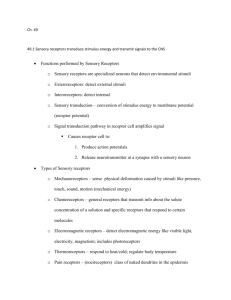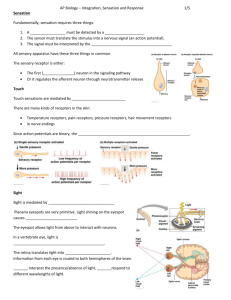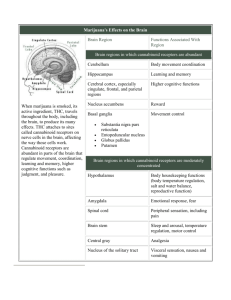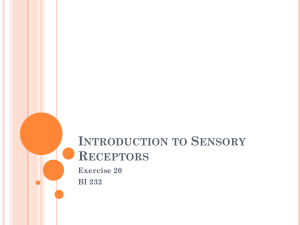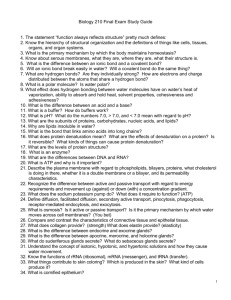Anatomical Terminology
advertisement
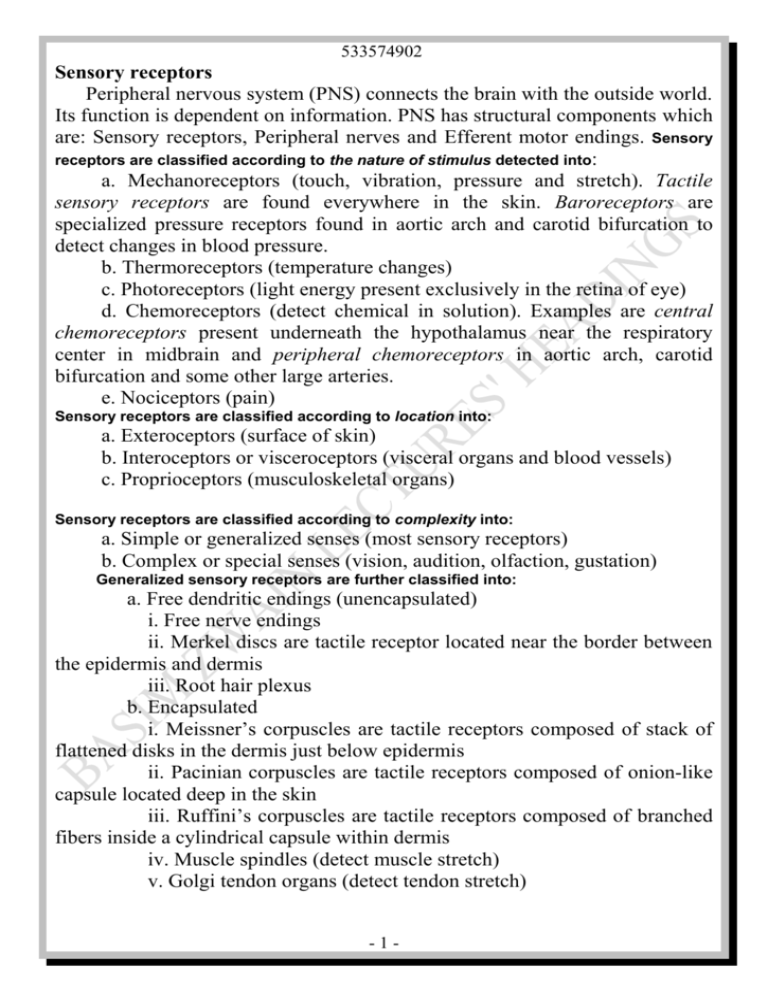
533574902 Sensory receptors Peripheral nervous system (PNS) connects the brain with the outside world. Its function is dependent on information. PNS has structural components which are: Sensory receptors, Peripheral nerves and Efferent motor endings. Sensory receptors are classified according to the nature of stimulus detected into: a. Mechanoreceptors (touch, vibration, pressure and stretch). Tactile sensory receptors are found everywhere in the skin. Baroreceptors are specialized pressure receptors found in aortic arch and carotid bifurcation to detect changes in blood pressure. b. Thermoreceptors (temperature changes) c. Photoreceptors (light energy present exclusively in the retina of eye) d. Chemoreceptors (detect chemical in solution). Examples are central chemoreceptors present underneath the hypothalamus near the respiratory center in midbrain and peripheral chemoreceptors in aortic arch, carotid bifurcation and some other large arteries. e. Nociceptors (pain) Sensory receptors are classified according to location into: a. Exteroceptors (surface of skin) b. Interoceptors or visceroceptors (visceral organs and blood vessels) c. Proprioceptors (musculoskeletal organs) Sensory receptors are classified according to complexity into: a. Simple or generalized senses (most sensory receptors) b. Complex or special senses (vision, audition, olfaction, gustation) Generalized sensory receptors are further classified into: a. Free dendritic endings (unencapsulated) i. Free nerve endings ii. Merkel discs are tactile receptor located near the border between the epidermis and dermis iii. Root hair plexus b. Encapsulated i. Meissner’s corpuscles are tactile receptors composed of stack of flattened disks in the dermis just below epidermis ii. Pacinian corpuscles are tactile receptors composed of onion-like capsule located deep in the skin iii. Ruffini’s corpuscles are tactile receptors composed of branched fibers inside a cylindrical capsule within dermis iv. Muscle spindles (detect muscle stretch) v. Golgi tendon organs (detect tendon stretch) -1- 533574902 Temporal properties of tactile receptors (adaptation) - Rapidly adapting fibers (RA) found in Meissner receptor and Pacinian corpuscle - fire at onset and offset of stimulation - Slowly adapting fibers (SA) found in Merkel and Ruffini receptors - fire continuously as long as pressure is applied Spatial Properties of tactile receptors (detail resolution) - Deep receptors: Pacinian receptors (RA2) and Ruffini receptors (SA2) have large receptive fields and respond to high vibration rates. - Surface receptors: Merkel receptors (SA1) and Meissner receptors (RA1) have small receptive fields and respond to slow vibration rates. Low vibration High vibration Slow adaptation Merkel receptors (SA1) Ruffini (SA2) Rapid adaptation Meissner receptors (RA1) Pacinian corpuscles (RA2) Merkel receptors Meissner receptors Ruffini cylinder Pacinian corpuscles -2- 533574902 Muscle spindle Muscle spindle is an example of encapsulated simple sensory receptors. It is composed of contractile region innervated by gamma () efferent (motor) fibers that maintain spindle sensitivity. Nuclear bag and nuclear chain fibers are sensory components wrapped by afferent sensory endings types Ia and II fibers to conduct information about the state of muscle stretch. Extrafusal muscle fibers are skeletal muscle fibers innervated by alpha () motor neurons. Sequence of events involves: a. Stretching the muscle activates muscle spindle b. Impulse carried by primary sensory fibers (Ia and II) to the spinal cord c. Activates alpha motor neuron which sends efferent signal to the extrafusal muscle fibers d. Stretched muscle contracts e. Antagonist muscle is reciprocally inhibited f. Gamma motor neurons contract the intrafusal fibers to maintain spindle sensitivity -3-

